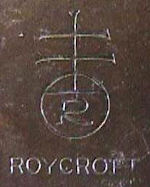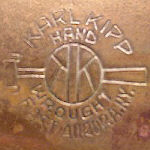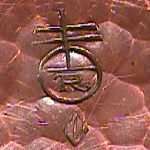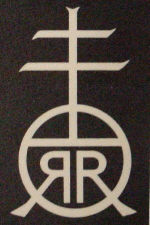
A note on dating pieces based on marks: unfortunately the myths associated with the dates of Roycroft copper marks have been further perpetuated by a Roycroft collector guide published in 2003. This (mis)guide provides the following incorrect dates: early mark: 1906 to 1910
After over 10 years of studying pieces, catalogs and marks, here is my guess at a more correct chronology: preliminary mark: 1906-1908 (only appears on a few crude forms) There was certainly some overlap in the use of the early, middle and late marks, meaning that a piece with a middle mark could have been made a little prior to 1920 or even after 1928. |
|
 |
Preliminary mark. The earliest Roycroft copper mark. You probably won't find this one in your travels as it only shows up on a couple rare pieces (one tray and a couple letter openers). Could be confused with a fake mark, but it's real, and dates to approximately 1906 before a real die stamp was made. The letter opener bearing this mark is in the Gallery. |
 |
Early mark. This one I refer to as the "big spindly" early mark. Note the long span of the crosses and their fineness. The big spindly shows up on really early things like hand-raised bowls, shaft vases, things with cutouts, etc. Like all the early marks, it has little curls on the ends of the R. |
 |
Early mark. This is another early mark, still large in size, but compare the proportons to the big spindly above.
|
 |
Early mark. This one I call the "little stubby" early mark. Note how it seems all squished together and thick. Frequently shows up on things that appear in the late teens catalogs like bullet vases and other smaller vases. Never appears on really early things. |
 |
Middle mark. Note the straight ends of the "R".
The middle mark has a few size variants.
|
 |
Late mark. Shows up on a lot of low quality stuff, but occasionally some nice stuff too. Note the word "ROYCROFT" below the orb and cross. |
 |
Here's a version of the late mark that shows up on some letter openers. |
 |
This mark occasionally appears on silver-plated pieces. This is an early mark variant, and based on catalogs, I think most of this stuff was made in the mid to late teens. |
 |
Early mark attributed to Walter Jennings. Note the two dots inside the orb. Also note how the crosses are short compared to the big spindly mark. I would guess that this mark is after WJ returned to Roycroft, so 1916-1920-ish. |
 |
Karl Kipp's mark while he was away from Roycroft. Dates to around 1911-1915. |
 |
Karl Kipp's other mark used at his "Tookay Shop". Probably dates to around 1914-1915, but also shows up on "Karl Kipp Shop" pewter which is later. |
 |
A very rare (and super-desirable!) combination mark including Karl Kipp's Tookay Shop mark along with an early Roycroft mark. It is speculated that the reason for this combination is that Kipp brought pieces from the Tookay Shop back with him when he returned to Roycroft in 1915 and the Roycroft mark was added. This combo was found on a rare cylinder vase (probably made by Jennings) and helps date the vase to around 1915. |
 |
A rare combination mark including Karl Kipp's KK mark with an early Roycroft mark. This may be either a pre-1912 (Kipp artist mark) combo, or a post-1915 (double signed) combo. |
 |
A combination of an early Roycroft mark (a big spindly!) along with Kipp's personal artist signature, indicating that he made the piece while at Roycroft (pre-1912 - see how we can start dating marks and things!). Found on a German silver jardiniere. |
 |
Bet you haven't seen this one before! One of the marks Walter Jennings used on things he made at home. This one was on a cylinder vase made in 1916. |
 |
The other mark that Walter Jennings used until his death. |
 |
A rare dated version of Walter Jennings' mark. Found on a pair of bookends. |
 |
Another rare dated version of Walter Jennings' mark. Found on a cylinder vase. |
 |
I think this is an artist mark. If so, I don't know who it represents. It was found on a small early low bowl. |
 |
The contemporary mark used to designate "Roycroft Renaissance" pieces. These are not antiques, not collectible, and not particularly valuable other than as decorative objects. |
 |
Here's a fake mark. Not very convincing once you know what to look for. |
 |
Another fake mark. |
 |
Another fake mark. Yikes!!!! |
